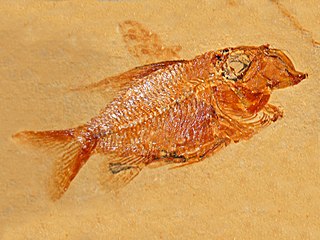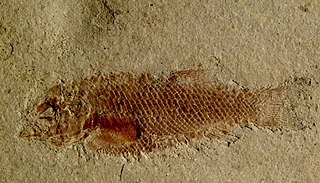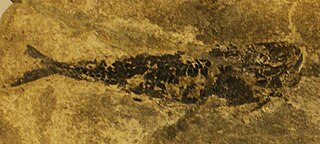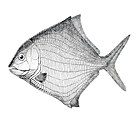Eosynanceja is an extinct genus of prehistoric ray-finned fish that lived during the lower Eocene.

Lissoberyx is an extinct genus of prehistoric ray-finned fish belongon to the family Trachichthyidae. Lissoberyx is a trachichthyid, but it shows more resemblance to the holocentrids than any other trachichthyid.

Elonichthys is an extinct genus of prehistoric freshwater ray-finned fish known from the late Paleozoic. The genus sensu stricto contains three species known from the latest Carboniferous to the earliest Permian of freshwater ecosystems of Europe, but as a former wastebasket taxon, it contains many more dubiously-classified species from the Carboniferous and Permian of Europe, Greenland, South Africa, and North America.

Euthynotus is an extinct genus of prehistoric bony fish that lived during the early Toarcian stage of the Early Jurassic epoch. It is generally considered the basalmost pachycormiform.
Pseudoegertonia is an extinct genus of prehistoric bony fish that lived during the Maastrichtian age of the Cretaceous period and Danian age of the Paleocene epoch.

Acanthonemus is an extinct genus of prehistoric marine ray-finned fish that lived from the early Eocene. It contains a single species, A. subaureus, known from the famous Monte Bolca site in Italy. It is the only genus in the extinct family Acanthonemidae.

Eolactoria sorbinii is an extinct prehistoric boxfish that lived during the Lutetian epoch of the middle Eocene, in Monte Bolca. It had two pairs of long spines, one over each eye, and one pair beneath the anal and caudal fins, arranged very similarly to those possessed by the modern genus Lactoria, but much longer. E. sorbinii had a fifth spine between the two eye-spines, arranged and looking very much like a nose.

Acentrophorus is an extinct genus of prehistoric freshwater and marine ray-finned fish from the Roadian to the Wuchiapingian of England, Germany (Kupferschiefer), Italy and Russia. There may also be a Triassic occurrence in Australia.
Sundayichthys is an extinct genus of prehistoric bony fish that lived during the Carboniferous period in what is now South Africa. Fossils were recovered from the Upper Witteberg Series.

Eoeugnathus is an extinct genus of prehistoric ray-finned fish belonging to the Halecomorphi. Eoeugnathus existed during the Middle Triassic in what is now Italy, Spain, and Switzerland. The type species is Eoeugnathus megalepis (monotypy).
Kentuckia is an extinct genus of prehistoric bony fish.

Meridensia is an extinct genus of prehistoric ray-finned fish that lived during the Anisian and Ladinian ages of the Middle Triassic epoch in what is now southern Switzerland and northern Italy. Fossils were recovered from the Besano Formation of Monte San Giorgio and Besano area at the Swiss-Italian boundary.
Pholidolepis is an extinct genus of prehistoric ray-finned fish.
Pholidophoroides is an extinct genus of prehistoric ray-finned fish.

Pholidopleurus is an extinct genus of prehistoric ray-finned fish.
Pleuropholis is an extinct genus of prehistoric ray-finned fish.

Protobalistum imperiale is an extinct prehistoric tetraodontid bony fish that lived from the Lutetian epoch of Eocene Monte Bolca.

Thoracopteridae is an extinct family of prehistoric bony fish classified with the order Peltopleuriformes, containing four genera: Thoracopterus, Gigantopterus, Potanichthys and Italopterus. This lineage of Triassic flying fish-like Perleidiformes converted their pectoral and pelvic fins into broad wings very similar to those of their modern counterparts. However, this group is not related to modern flying fish from the family Exocoetidae, instead being a case of convergent evolution.

Spinacanthidae is an extinct prehistoric family of tetraodontid bony fish that lived from the Lutetian epoch of Eocene Monte Bolca.





















